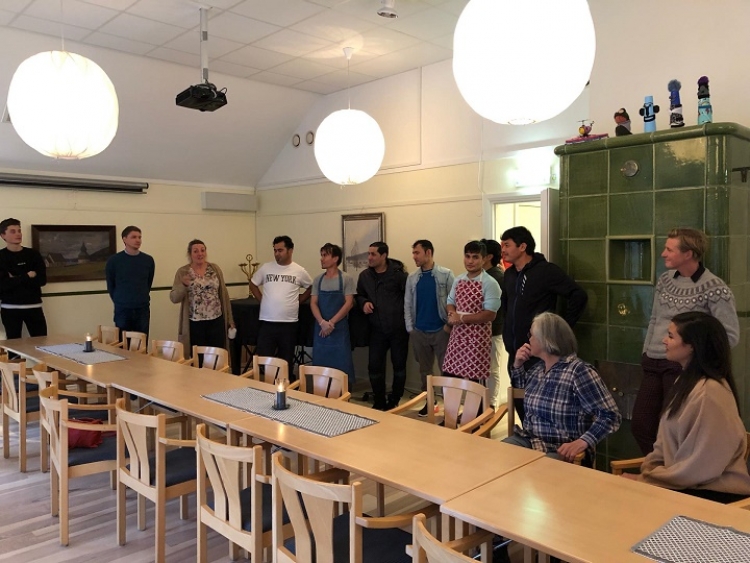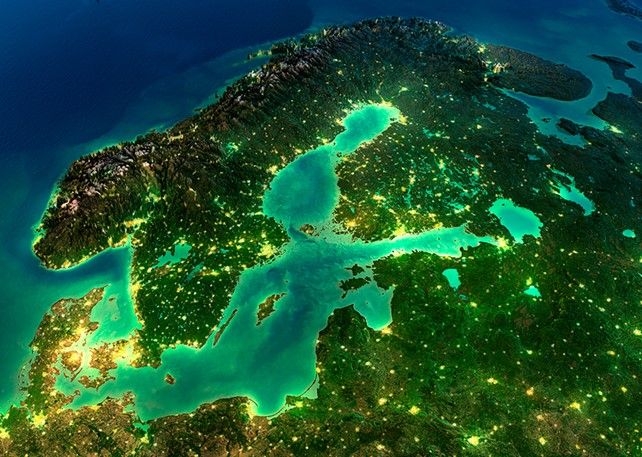Estonian delegation adds to its knowledge of migration and integration issues in Scandinavia

Estonian public servants and representatives of NGOs from the country were recently introduced to positive examples of the integration of migrants on visits to Åre in Sweden and the Norwegian capital Oslo.
The main aim of the trip was to study the links between national integration strategies and measures designed to get people involved in the labour market. The participants also examined the structure of the labour markets in Sweden and Norway, private-sector preferences in both countries and the relationship between the aforementioned inclusion measures and existing integration initiatives – at both the non-governmental and local authority levels. Ways of using existing resources and local initiatives to get refugees and migrants involved to the greatest possible extent were also studied.
Åre local authority: a dedicated team
In Åre in Sweden the participants met with Mayor Peter Jansson, the heads and coordinators of integration and development from the local authority and representatives of the Swedish Migration Agency. During discussions they shared their thoughts on and experience of integration-related issues at both the local and national levels and outlined ambitious future plans.
Åre stood out for its personalised and empathic approach to those newly arrived in the country. Much of their focus is on face-to-face communication, including home visits, and consideration is given to the kind of technology that could help people adapt and settle in. In this regard no distinction is made between tourists from Stockholm and refugees from Somalia. Locals themselves do everything they can to ensure that new arrivals don’t leave, since the local authority needs taxpayers in order to function. The department overseeing growth is charged with the task of finding and retaining such people. Everyone is made to understand that all of this must be done whilst ensuring sustainability. As such, wide-ranging assistance is provided in helping people find places to live and work. Of primary importance is guaranteeing newcomers the chance to learn the local language. In integrating people, the recipients are offered security, comfort and convenience so that they choose to remain in the local authority area.
Discussions underscored the importance of talking to local residents and outlining and explaining the situation to them, since any new situation meets with resistance until people grow used to it. It was also mentioned that for integration to work, it requires bold leaders and bold decisions at the political level. Since 2011, Åre has provided asylum to 798 people. The local population is 11,500. The refugee quota in Sweden this year is 5000 people.
Where the situation differs from that in Estonia is in local authorities largely having carte blanche when it comes to using the money allocated to it by the state for migrants. Local authorities also take on many of the tasks of the Swedish Public Employment Service if they see that there are areas of concern they ought to address. In Estonia, the rules for obtaining support are so inflexible that the majority of local authorities avoid involving themselves in integration matters.
Between the presentations, the Estonian delegation had the opportunity to visit a local primary school, an adult education centre and a variety of companies, all of which are experienced in integrating migrants into local life. They focus on refugees and immigrants alike, whatever their reasons for coming to live in Sweden.
For example, they have set up a language café at which people get together every Tuesday to practise their Swedish while trying foods from different countries. A local church space serves as the venue for the café, which attracts migrants, volunteers, local authority workers and residents: everyone is welcome. The Estonian delegation had the chance to attend one of the café get-togethers, where they tried food from Afghanistan and chatted to the immigrants, who all said they were very satisfied with the work and study opportunities offered to them and the welcome they had received – even if adapting to the climate was something of a struggle.
Everyone in the delegation was impressed with the dedication of the local authority and its workers, which was reflected in everything they said and did in welcoming the Estonians as visitors as well. Talking together after the meetings, all of the delegation members said that the trip had made them even more motivated to assist migrants in Estonia and to further develop existing support systems in the country.
Norway: years of experience in dealing with migrants
In Oslo, the Estonian delegation were welcomed at the Ministry of Education and Research, the Directorate of Integration and Diversity (IMDI), the Labour and Welfare Administration (NAV) and the Centre for Refugees and Immigrants (SeFi). As in Sweden, they met with local employers who give migrants and asylum seekers the chance to make something of themselves. For example, the well-known chain Clas Ohlson offers them opportunities to work in its stores, practise the language and forge a career. All they need to achieve this is sufficient motivation and patience.
In addition to refugees, there is a significant amount of labour-based immigration in Norway. As of 1 January 2019 the Norwegian population comprised 14% immigrants and 3% children of immigrants born in the country alongside the remaining 83% of the native populace.
Those with a refugee background make up 4% of the overall population and 30% of the immigrant population. Poles form the largest minority among immigrants, while there are 4763 Estonians in Norway.
As in Sweden, new arrivals to Norway are provided with language lessons and are introduced to local laws and regulations, so as to avoid misunderstandings and unpleasant surprises. Although the requirement in Norway at present for migrants to obtain citizenship is Norwegian skills at the A2 level, a proposal has been made at the political level to raise this to B1, as in the other Scandinavian countries. Dual citizenship will be allowed from 2020.
Whereas in Sweden the Estonian delegation focussed mainly on the local authority level, in Norway they gained an overview of activities at the national level aimed at integrating migrants into society. Norway has many years of broad-ranging experience in dealing with immigrants and asylum seekers. The visitors from Estonia were given a comprehensive overview of the integration programme implemented in Norway. As in other fields, a great many decisions are made at the political level and funding is unfortunately being scaled back. Since the peak of the so-called migration crisis has passed, governments do not consider it important to contribute to integration issues to the same extent. This is true in Sweden as it is elsewhere. Nevertheless, public officials and NGOs are doing their best to maintain a sufficient degree of integration for migrants.
It was delightful to see workers who are happy to contribute their own time and energy to immigrants, since in fact there is a shortage of labour throughout the Nordic region. As such, we should be giving more consideration to the placement of our resources and taking actual steps with a view to the future. In order for the region to be strong, there must be shared understandings and discussions.
Feedback from participants
The delegation members found something in the experiences of both countries that they could make use of in their own work. They all agreed that the trip had been an eye-opening and very useful one. They were reassured to see that many of the services offered by the state at the local authority level in the Scandinavian countries already form part of the support services provided in Estonia (for example as part of Pagulasabi). The problem in Estonia is rather a lack of migrants to whom to offer the services. In any event, the trip gave the participants new ideas on how to design existing Estonian services to be even better. Contact details were exchanged so that the Estonian, Swedish and Norwegian counterparts could continue to share their experiences and maintain a dialogue. The participants felt that similar trips would be of benefit to employees of local authorities in Estonia and to case workers from the Estonian Unemployment Insurance Fund as people who deal with new migrants on a daily basis. The main difference between the Scandinavian countries and Estonia remains people’s attitudes towards migrants.
Seminars on labour market vulnerabilities and special needs
The trip was followed by two international seminars: one in Tallinn on 17 October and one in Tartu on 18 October. Making presentations at the seminars were experts from Estonia, Sweden and Norway, based on whose experience the situation in Estonia of labour-related integration was discussed. The events also focussed on support measures promoting the integration of new immigrants on the labour market that would be able to be implemented in the Estonian context. Furthermore, the participants discussed the roles that representatives of the public, private and third sectors play and touched on the issue of study migration.
Both the seminars and the visit to Sweden and Norway took place in cooperation with the UN Refugee Agency, the Nordic Council of Ministers’ Office in Estonia, the Estonian Ministry of the Interior and the NGO Johannes Mihkelsoni Keskus.
Migration and Integration in the Nordic-Baltic Region 2018-2019
The seminars and trip took place as part of the two-year ‘Migration and Integration in the Nordic-Baltic Region 2018-2019’ project, which is designed to boost cooperation between the Nordic countries and Baltic States in dealing with growing migration. It focuses on exchanging knowledge and practical experience in the field of migration and on integrating migrants. The main activities of the project have been the in-depth conferences held at KUMU in Tallinn and public seminars in both Tallinn and Tartu. At these gatherings, the participants discuss how to more effectively integrate migrants into local life and share their experiences at the level of the state, local businesses and NGOs.


